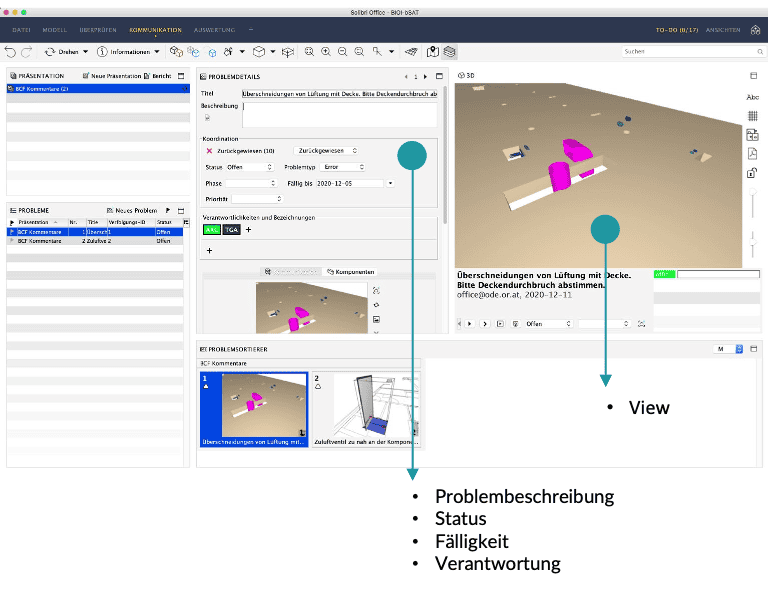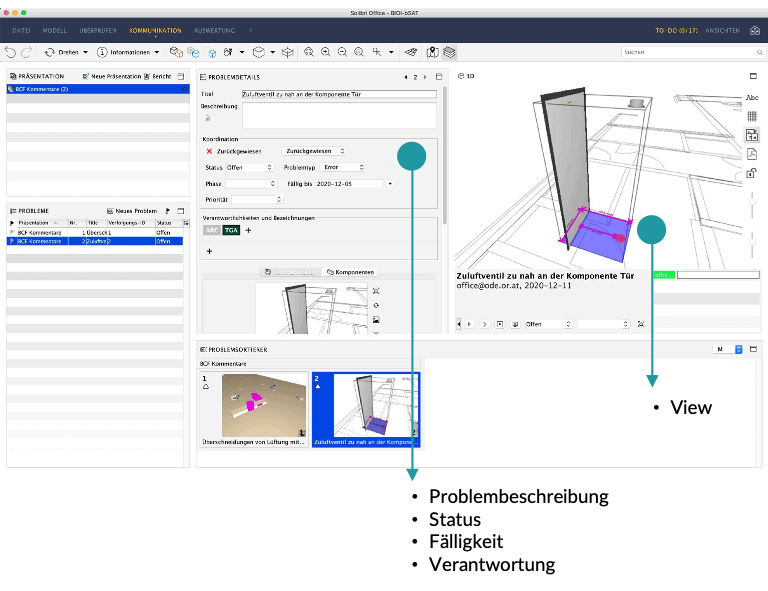BCFs identify questions and problems relating to specific model elements and are used to communicate defects between the BIM organizational units. In the interaction between the ISO and buildingSMART standards, BCF assumes the role of the data interface for communication – without transporting specific model elements.
BCF (or BCF comments) always contain:
- the GUID(GloballyUnique Identifier),
- the assigned name,
- Stored viewpoint(s) with camera position on selected model elements, visibility and coloring of model elements (IFC coordinates),
- Images (in relation to the viewpoints),
- Annotations in 3D space,
- Description, date, author, addressee, group assignment (e.g. discipline or BIM organizational unit),
- Comments (author, date, focus),
- attached files and
- the status (e.g. open, closed).
With BCF 3.0, it is also possible to transfer individual additional features/information using a BCF. On this basis, BCF can also be used to handle more complex use cases in which more comprehensive declarations need to be exchanged – for example, the use case of connection coordination. In principle, it is also possible to transfer model features using BCF – a function that is being launched under the term “BIM snippets”. However, this requires the corresponding functional scope of the BIM applications involved.
As a standardized XML file (file extension “.bcf” or “.bcfzip”), a BCF does not contain the model or parts of it, but establishes a reference relationship to model elements via their GUID. The GUID is an automatically generated number with 128 bits; it is unique and cannot be changed.
Their simple format allows software manufacturers to easily integrate the functionality into the respective application. BCFs are used by all BIM organizational units. Their main function is in the area of quality assurance for model management, as they both communicate and document problems. However, BCFs are also used in coordination cases between BIM specialist coordination and BIM creators in order to be able to coordinate specific questions on model and planning content (see Fig. 3.40).

BCF comments can also be used differently in the service phases:
in the design phase:
- Documentation of quality assurance/quality control (QA/QC),
- Identification of design coordination problems (collision detection) between specialized models and
- Commenting on design options, object alternatives and materials.
in the tendering and awarding phase:
- Coordination of the tender and clarifications and
- Cost and supplier information for objects, assemblies and/or systems.
in the construction phase:
- Quality assurance/quality control (QA/QC) of installation records,
- Tracking the availability of articles/materials and coordinating replacement products and
- Collection of last-minute information for handover to the owner/operator.
in the operating phase:
- Information on handover models in the event of changes to the system and its many elements during operational use, and
- Owner’s notes on necessary improvements.
The BCF comments should always be described precisely, briefly and neutrally. The selected viewing positions on the model content should always be clearly displayed (through visibility and coloring). The status of the BCF comments should also always be kept up to date. The status should be set to “closed”, especially when problems have been solved. These guidelines enable a good workflow between all project participants and ensure that the BCF functionality can also be used clearly outside of your own applications.
Regardless of the time and use: BCF comments should always be exchanged via a defined platform in the interests of transparency and consistency. This can be the CDE of the respective project or an additional web-based collaborative platform intended for this purpose. A good platform always provides a good overview of the status of a project via its functionalities and displays – this can be mapped via the BCF comments. The assignment to groups (BIM organizational units and specialist models), responsibilities in the problems and the status of all BCF comments not only allows individual critical points to be identified, but also critical project services to be mapped in good time.
The following illustrations show typical BCF comments. The problem description, status, due date and responsibility are shown in the middle section. The corresponding views (viewpoint with camera position on selected model elements) can be seen on the right.


Publication from Eichler, C.C., Schranz, Ch., Krischmann, T., Urban, H., Hopferwieser, M., Fischer, S.: BIMcertHandbuch- Grundlagenwissen openBIM. Issue 2024. Mironde-Verlag, Niederfrohna, 2024. DOI: 10.34726/5384
URL: https://repositum.tuwien.at/bitstream/20.500.12708/192612/3/Eichler-2024-BIMcert %20Handbuch%20basic-knowledge%20openBIM-vor.pdf
Status: 23.01.2024
